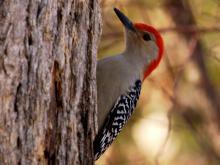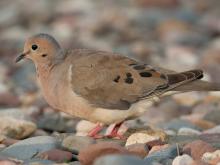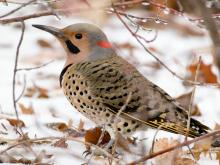Birds
Media

Species Types
Scientific Name
Melanerpes carolinus
Description
A striking woodpecker with grayish white face and underparts, black-and-white banded upperparts, and a red band on the head or nape. The red belly is often not noticeable.
Media

Species Types
Scientific Name
Bonasa umbellus
Description
Restoration efforts are raising the numbers of this chickenlike bird in our state. Look for brown, rufous, and gray streaks, bars, and bands. A dark ruff on the neck appears on both sexes but is used by the male in courtship displays.
Media

Species Types
Scientific Name
Pluvialis dominica
Description
The American golden-plover is a robin-sized shorebird that makes an incredible annual odyssey from Argentina to the Arctic tundra, a distance of over 20,000 miles. It flies through Missouri in spring.
Media

Species Types
Scientific Name
Zenaida macroura
Description
Doves symbolize peace, and they are also a popular quarry of hunters. Our mourning doves are probably the closest living relatives of the extinct passenger pigeon. Learn more about these cooing seed-eaters!
Media

Species Types
Scientific Name
Colaptes auratus
Description
America’s flickers used to be considered three different species, but in the 1980s biologists determined otherwise. Now, our eastern “yellow-shafted” flicker, the “red-shafted” flicker of the west, and the “gilded flicker” of the southwest are all considered just forms of the same species: the northern flicker.
Media

Species Types
Scientific Name
Tringa melanoleuca
Description
One of the more common of about 35 shorebirds that migrate through Missouri, the greater yellowlegs is large, with a slightly upturned bill and long, bright yellow legs.
Media

Species Types
Scientific Name
Scolopax minor
Description
This remarkable bird is a short-necked, short-legged, terrestrial shorebird with a long bill. The eyes are set back on its head. When this bird is flushed, its short wings make a startling whirring sound.
Media

Species Types
Scientific Name
Gallinago delicata
Description
Wilson’s snipe, formerly called the common snipe, is a migratory game bird in Missouri. Like its relative the woodcock, this member of the sandpiper family is not usually seen on mudflats. It prefers swamps and wet, grassy areas.
Media

Species Types
Scientific Name
Spatula clypeata (formerly Anas clypeata)
Description
Northern shovelers are dabbling ducks with remarkably long, heavy-looking bills. The male’s green head may remind you of a mallard’s, but the bill is far heavier.
Media

Species Types
Scientific Name
Anas strepera
Description
The male gadwall is a rather drab-looking duck with a black rear end and a white speculum (wing patch). This dabbling duck is a common migrant in Missouri.
See Also







Media

Species Types
Scientific Name
Hemaris diffinis
Description
The snowberry clearwing is a moth that confuses people because it looks like a bumblebee and flies like a hummingbird!
Media

Species Types
Scientific Name
Hyles lineata
Description
The white-lined sphinx moth sometimes confuses people because it flies, hovers, and eats from flowers like a hummingbird. The adults often fly during daylight hours as well as in the night and are often found at lights.
Media

Species Types
Scientific Name
Darapsa myron
Description
The Virginia creeper sphinx moth is common in woods and brushy areas and comes to lights at night. The larvae eat Virginia creeper and grape leaves.
Media

Species Types
Scientific Name
Perimyotis subflavus (formerly Pipistrellus subflavus)
Description
Tri-colored bats, formerly called eastern pipistrelles, are relatively small and look pale yellowish or pale reddish brown. The main hairs are dark gray at the base, broadly banded with yellowish brown, and tipped with dark brown.
Media

Species Types
Scientific Name
Myotis grisescens
Description
Gray myotises are difficult to distinguish from other mouse-eared bats. A key identifying feature of the gray myotis is that its wing is attached to the ankle and not at the base of the toes. It’s an endangered species.
Media

Species Types
Scientific Name
Myotis lucifugus
Description
The little brown myotis (little brown bat) is one of our most common bats, but populations are declining. White-nose syndrome has taken a heavy toll in northeastern states. This species is now listed as vulnerable across its range.
Media

Species Types
Scientific Name
Myotis sodalis
Description
The Indiana myotis, or Indiana bat, summers along streams and rivers in north Missouri, raising its young under the bark of certain trees. It is an endangered species.
About Birds in Missouri
About 350 species of birds are likely to be seen in Missouri, though nearly 400 have been recorded within our borders. Most people know a bird when they see one — it has feathers, wings, and a bill. Birds are warm-blooded, and most species can fly. Many migrate hundreds or thousands of miles. Birds lay hard-shelled eggs (often in a nest), and the parents care for the young. Many communicate with songs and calls.





















